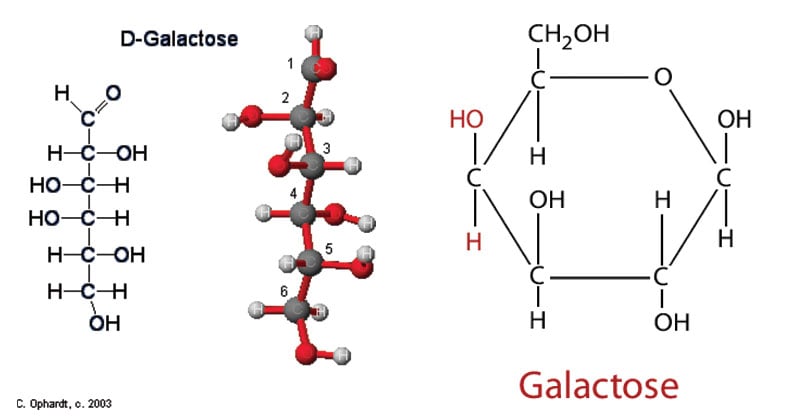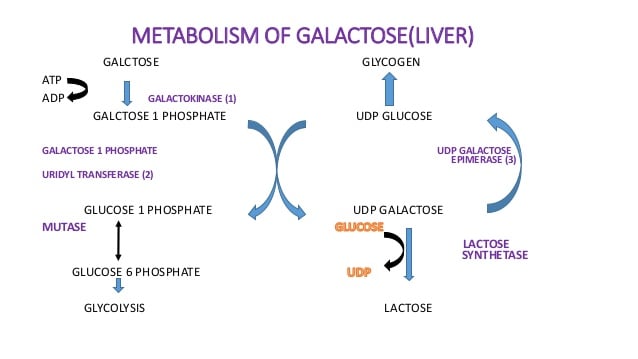Galactose Metabolism is the conversion of Galactose into Glucose-6-phosphate that takes place in the cytoplasm of cells of the liver.
The complex process of metabolism is how living things turn different materials into energy and fundamental building blocks for upkeep and growth. The use and breakdown of sugars, which are essential for powering cellular processes, is a vital part of metabolism.

Galactose, a monosaccharide included in dairy products and some fruits, is a crucial source of energy and a building block for several biomolecules. The fascinating world of galactose metabolism is explored in this article, including with its location, process, outcomes, energy needs, relevance, and links to related disorders.
- Galactose is a major dietary sugar for humans.
- The hydrolysis of the disaccharide lactose (in milk) yields galactose and glucose.
- Galactose and glucose are epimers that differ in their configuration at C-4.
- Thus the entry of galactose into glycolysis requires an epimerization reaction.
- This occurs via a four-step pathway called the galactose–glucose interconversion pathway.
Interesting Science Videos
Galactose Metabolism Location
Galactose metabolism takes place primarily in the cytoplasm of cells of the liver.
The liver is the primary organ responsible for galactose metabolism, but other organs including the intestines and kidneys also play a role. After passing through the intestinal epithelium and entering the portal vein, galactose is transported to the liver where it is subjected to a number of enzymatic processes.
Galactose Metabolism Steps and Pathway
Galactose metabolism proceeds through a number of enzymatic processes. Galactokinase, an enzyme, phosphorylates galactose to create galactose-1-phosphate when it enters the liver. The enzymes galactose-1-phosphate uridylyltransferase (GALT) and galactose-1-phosphate uridylyltransferase (GALT-1P) then convert galactose-1-phosphate to glucose-1-phosphate. After that, glucose-1-phosphate is changed into glucose-6-phosphate, which can then be used in glycolysis or stored as glycogen for later use as energy.
1. Phosphorylation
- The first step in galactose metabolism is the phosphorylation of galactose to galactose-1-phosphate.
- This reaction is catalyzed by the enzyme galactokinase and requires the input of ATP.
The chemical reaction can be represented as follows:
Galactose + ATP → Galactose-1-phosphate + ADP
2. Conversion to Glucose-1-phosphate
- Galactose-1-phosphate is then converted to glucose-1-phosphate through a series of enzymatic reactions.
- The enzyme galactose-1-phosphate uridylyltransferase (GALT) transfers a uridine monophosphate (UMP) group to galactose-1-phosphate, forming UDP-galactose and glucose-1-phosphate.
- The UDP-galactose is then epimerized by the enzyme UDP-galactose 4-epimerase to form UDP-glucose.
The chemical reactions involved can be summarized as follows:
Galactose-1-phosphate + UTP → UDP-galactose + PPi
UDP-galactose → UDP-glucose
3. Conversion to Glucose-6-phosphate
- Finally, glucose-1-phosphate is converted to glucose-6-phosphate, which can enter glycolysis or be stored as glycogen for future energy needs.
- This conversion is facilitated by the enzyme phosphoglucomutase.
The chemical reaction can be represented as follows:
Glucose-1-phosphate ↔ Glucose-6-phosphate

Galactose Metabolism Results
The breakdown of galactose in galactose metabolism produces a number of significant outcomes that help the body operate as a whole. The following are the main effects of galactose metabolism:
1. Production of Glucose
- Glucose production is the main outcome of galactose metabolism.
- In order to create glucose-6-phosphate, galactose must first be transformed to glucose-1-phosphate.
- A crucial intermediary in several metabolic processes, including glycolysis, glycogen production, and the pentose phosphate pathway, is glucose-6-phosphate.
- Glucose-6-phosphate can be further metabolized to create ATP, which serves as the cell’s primary source of energy.
2. Energy Production
- Galactose is broken down and then converted to glucose, which leads to the production of ATP, which provides energy.
- In the glycolytic route, where it is further metabolized to make ATP through the process of cellular respiration, glucose-6-phosphate, which is formed from galactose metabolism, might enter.
- This energy is essential for cellular processes including muscular contraction, the transmission of nerve impulses, and the creation of large molecules.
3. Synthesis of Biomolecules
- The galactose metabolism also supplies the raw materials needed to create necessary biomolecules.
- Galactose, from which glucose-6-phosphate is generated, can be utilized for nucleotide synthesis, assisting in the creation of DNA and RNA, which are essential for the synthesis of both genetic material and proteins.
- Additionally, glucose-6-phosphate functions as a precursor for the creation of complex carbohydrates like glycolipids and glycoproteins, vital parts of cell membranes involved in immune response control, cell signaling, and recognition.
4. Glycogen Storage
- Glucose-6-phosphate, which is produced by the metabolism of galactose, may also be changed into glycogen, a type of glucose that is stored in the body.
- When energy needs rise, such as during times of fasting or vigorous exercise, glycogen—which is predominantly stored in the liver and skeletal muscles—serves as an easily accessible supply of glucose.
- The production of glycogen guarantees that there is always enough glucose available to fulfill the needs of the various tissues and organs.
5. Maintenance of Blood Glucose Levels
- Galactose metabolism contributes to the regulation of blood glucose levels.
- The conversion of galactose to glucose and subsequent glucose utilization and storage help maintain the balance between glucose production and utilization in the body.
- This ensures that blood glucose levels remain within the normal range, providing a steady supply of energy to cells.
Galactose Metabolism Energy Requirement
- Galactose metabolism generates energy predominantly through the transformation of galactose into glucose-1-phosphate and then glucose-6-phosphate.
- Adenosine triphosphate (ATP) is a necessary input for the phosphorylation reaction, which is catalyzed by the enzyme galactokinase.
- The fundamental energy unit of the cell is the high-energy molecule ATP.
- Galactose is phosphorylated to galactose-1-phosphate as the first step in the metabolism of galactose.
- Adenosine diphosphate (ADP) is created as a byproduct of this process, which uses one ATP molecule.
The following is a representation of the conversion:
Galactose + ATP → Galactose-1-phosphate + ADP
The transfer of a phosphate group to galactose, which activates it for further metabolic events, is made possible by the energy given by ATP. Additionally, ATP is not directly used during the subsequent conversion of galactose-1-phosphate to glucose-1-phosphate by the enzymes galactose-1-phosphate uridylyltransferase (GALT) and UDP-galactose 4-epimerase.
However, other energy sources like glucose-1-phosphate and UTP (uridine triphosphate) must be used in order to synthesize and use UDP-galactose and UDP-glucose.
Significances of Galactose Metabolism
For human growth and health, galactose metabolism is of utmost importance. Especially during infancy, when breast milk, which is high in lactose, serves as the main source of nourishment, it is crucial for supplying energy. Galactose is also necessary for the production of complex carbohydrates, which are critical for appropriate cell communication and operation.
Galactose also contributes to the synthesis of glycolipids, which are necessary for the maintenance of cell membranes and help in signaling and cellular recognition.
Galactose Metabolism Related Diseases
- Galactose metabolism is essential for healthy physiological functions, although serious diseases can result from deficits in certain enzymes that are part of this system.
- Due to a deficit in one of the enzymes involved in the metabolism of galactose, people with an uncommon genetic condition known as galactosemia are unable to metabolize the sugar.
- The most typical kind of galactosemia is brought on by a GALT deficit, which causes a buildup of galactose and its metabolites in different organs.
- Galactosemia can cause intellectual impairment, cataracts, liver malfunction, and stunted growth.
- A diet free of galactose and early detection is crucial for controlling this illness.
Conclusion
An important sugar present in many food sources, galactose may be broken down and used thanks to a complex system called galactose metabolism. Galactose metabolism is mostly controlled by the liver, which transforms galactose into glucose, a fuel source and building block for vital proteins. The process is ATP-dependent and makes a considerable contribution to the synthesis of complex carbohydrates, glycolipids, and glycoproteins as well as energy.
Galactose metabolism-related enzyme deficits, however, can result in serious conditions such as galactosemia. Galactose metabolism is complex, and knowing it better not only broadens our understanding of cellular functions but also sheds light on the treatment and diagnosis of disorders that are connected to it.
References
- David Hames and Nigel Hooper (2005). Biochemistry. Third ed. Taylor & Francis Group: New York.
- Smith, C. M., Marks, A. D., Lieberman, M. A., Marks, D. B., & Marks, D. B. (2005). Marks’ basic medical biochemistry: A clinical approach. Philadelphia: Lippincott Williams & Wilkins.
- John W. Pelley, Edward F. Goljan (2011). Biochemistry. Third edition. Philadelphia: USA.
- Galactose Metabolism – https://pubchem.ncbi.nlm.nih.gov/pathway/PathBank:SMP0000043
- Galactose – https://www.sciencedirect.com/topics/neuroscience/galactose
- Chapter 12: Carbohydrates: Galactose Metabolism – https://accesspharmacy.mhmedical.com/content.aspx?bookid=1696§ionid=111398648
- Galactose Metabolism – https://step1.medbullets.com/biochemistry/102056/galactose-metabolism
- Galactose metabolism – https://www.uniprot.org/keywords/KW-0299
- Galactose Metabolism – https://www.pharmacy180.com/article/galactose-metabolism-1891/

This is a great job and it’s helpful, I really recommend this site to workers and students in science field of study
i like the how briefly it is explained in such simple words !!